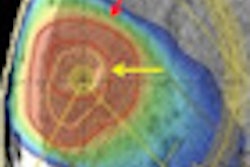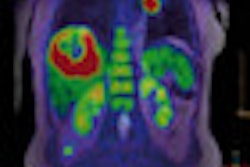Nuclear medicine radiographers are well known for their skill at performing complex examinations, but they score lower overall than other subspecialties in emotional intelligence, according to a new survey that could end up arousing the curiosity of all imaging professionals, as well as testing their patience.
The survey of nearly 2,000 radiographers in different imaging subspecialties arrives at several intriguing conclusions, some of which will need more research to fully explain, but that the authors believe are important to measure in the effort to better understand the personality traits associated with all of the helping professions from physicians to teachers and dentists.
"Emotional intelligence (EI) is a potentially valuable attribute in many professions including medicine, dentistry, and nursing," wrote Dr. Stuart MacKay from the University of Salford, in Salford, U.K. and colleagues from the Ursula Keyes Breast Screening Unit in Chester. "For example Arora et al [in 2010] undertook a systematic review to identify the value of emotional intelligence in medicine using medical education competencies and reported that EI was positively associated with compassionate and empathic patient care, higher-scoring assessment of knowledge and effective coping with organizational pressures and leadership. EI also contributed to improved teamwork and doctor-patient communication." (Radiography, 16 December 2011, published online)
Previous studies have shown that the impact of employee EI on those receiving services results in positive outcomes in customers' perceptions and loyalty. "This could have clear implications for healthcare settings, where patients' willingness to attend and compliance with interventions are vital," the authors wrote.
The online survey was conducted using the Trait Emotional Intelligence Questionnaire, a self-report measure. The authors used three main analyses to investigate any differences between the sample and population, the radiographer subgroups and the sample, and a normative group comprised of various nonmedical professions.
"The aim of this study was to profile the trait emotional intelligence of the radiography profession, explore any differences between subgroups, compare the profession with a normative group, and investigate the relationship between EI and the leaders of the profession," MacKay et al wrote.
The independent variables used included gender, grading, age group, type of work (radiographer specialty), type of diagnostic radiographer subspecialty (DR), and mode of practice. The dependent variable consisted of scores of global trait EI, well-being, self-control, emotionality, and sociability.
The study used the 30-item short form of the Trait Emotional Intelligence Questionnaire, which has shown good validity and reliability in previous studies, they stated. Seniority levels of NHS staff (ranging from 4 to 8C, the highest level) were determined by a framework known as "Agenda for Change" which ranks staff according to their skills and responsibilities.
The cohort was divided by work type including diagnostic, therapeutic, assistant practitioner, and nuclear medicine technologist. Practitioner types included angiographer, trauma, MRI, general, mammographer, ultrasonographer, and CT specialist. Mode of practice divided radiographers into the categories of education, clinical practice, research, management, and other.
The comparison normative group (n=866) was derived from a range of private and public sector jobs, and the armed forces.
According to the results, global trait EI showed statistically significant main effects for grading (p=0.014) and type of diagnostic radiography (p=0.05). Notwithstanding its statistical significance, actual differences in mean scores were small between groups. Post-hoc (Tukey-Kramer method) comparisons showed no differences for grading, however, angiographer groups (mean 5.60) scored significantly (p≤ 0.05) higher than nuclear medicine specialists (mean 5.14). No other differences were significant, but CT specialists (mean 5.22) didn't fare much better than the nuclear medicine group.
Participants with higher scores for well-being "perceive themselves as successful and confident, cheerful and satisfied, and tending to look on the bright side of life," the authors explained.
In the well-being assessment, statistically significant main effects were revealed for type of work, type of diagnostic radiography, and grade of work, although post-hoc comparisons found no significant differences for practice or work type. As in the global score, actual differences between subspecialties were small. Topping the list in well-being were angiographers (mean 6.12), trauma radiographers (mean 5.89), and mammographers (mean 5.86), while the bottom was again populated by nuclear medicine radiographers (5.46) and CT specialists (mean 5.67), with ultrasound, MRI, and general radiographers occupying the middle ground.
Those with higher scores in self-control "are better able to control their emotions, to withstand pressure, and regulate stress and are reflective and less likely to give in to their urges," the authors wrote.
In self-control there were significant main effects for job grade (p=0.05), with post-hoc comparisons showing significantly higher self-control scores among the Band 6 professionals compared to Band 8a group.
Subjects with higher emotionality scores "believe they are clear about their own and other people's feelings, capable of communicating their feelings to others, of having fulfilling personal relationships, and capable of taking someone else's perspective," MacKay et al wrote.
Emotionality showed significant main effects for type of diagnostic radiography, with angiographers (mean 5.62) and mammographers (mean 5.58) scoring higher than trauma (mean 5.27) and, once again, nuclear medicine (mean 5.12) specialists. Post-hoc comparisons showed significantly higher mean scores for mammographers versus nuclear medicine radiographers.
In sociability, significant main effects were found for type of work (management, teaching, etc.) and grade of employment, though again actual differences were small. Post-hoc comparisons showed no significant differences for work type but higher sociability levels for higher grades (Band 6 median 4.81, higher-level Band 8a, median 5.10, Band 8b, Median 5.30). Finally, a Pearson's product moment correlation coefficient comparison between global EI and four factors showed a small but positive correlation between work grade and sociability (p ≤0.01).
The study is the first to examine global intelligence within a large health service profession, and showed higher emotional intelligence for radiographers than the normative sample, "especially among females who make up 80% of the profession," the authors noted.
Principally "there were differences between types of radiographer, with nuclear medicine radiographers scoring consistently lower than other groups," MacKay et al reported.
"Angiographers and mammographers scored highly for emotionality and well-being, with angiographers also scoring highly for global EI," they wrote. "It is unclear why this might be, as the basic education and training for all DR is the same, a BSc honors degree in diagnostic radiography," the authors wrote. "This might be related to different characteristics of the subspecialties such as the degree of focus on the technology or the relationship with the patient, and this might attract different personalities. Anecdotal evidence suggests that nuclear medicine radiographers might have a greater focus on the technology and mammographers on their relationship with their patients, but further research is required to try and explain this phenomenon."
Differences between leaders and other members of the profession were most evident in sociability. Still, radiographers overall scored higher than the normative group for global EI and three of the four trait factors. There were no significant differences between diagnostic and therapeutic work types, but further research is needed to explore why these differences were present, and why the previously identified differences did not materialize with this measure, the group noted.
The study successfully benchmarked trait EI of one healthcare profession and identified areas for future research to further the understanding of emotional intelligence, the authors concluded.




















